SWOT Analysis of Non-Technical and Technical Measures towards “(Nearly) Zero-Emission Stove Technologies”
Abstract
:1. Introduction
2. Material and Methods
2.1. Primary Measures (Emissions Prevention)
2.1.1. Non-Technical Primary Measures
- General information about “correct heating”;
- Hands-on user training;
- Quick User Guide (QUG).
2.1.2. Technical Primary Measures
- Air supply and air staging concept;
- Combustion chamber design;
- Draught control and automatic combustion air regulation devices;
- Alternative (or advanced) combustion concepts.
2.2. Secondary Measures (Emissions Reduction)
- Packing technology (oxidizing reactors);
- Catalysts;
- Foamed ceramics (non-catalytic);
- Fabric baghouse filters;
- Electrostatic precipitators (ESP).
2.3. SWOT Analysis
3. Results
3.1. State of Knowledge about User Behavior
3.1.1. Selection of Firewood
3.1.2. Ignition Technique
- Bottom-up ignition technique
- Top-down ignition technique
3.1.3. Time of Recharging
3.1.4. Batch Mass of Fuel
3.1.5. Positioning of Firewood in the Combustion Chamber
3.1.6. Air Valve Settings
3.1.7. Number of Batches
3.2. State of the Art of Non-Technical Primary Measeurs
- General information about “correct heating”;
- Hands-on user training;
- Quick User Guide (QUG).
3.2.1. General Information about “Correct Heating”
3.2.2. Hands-On User Training
3.2.3. Quick User Guide (QUG)
- Preparation and ignition;
- Recharging at nominal load;
- Recharging at part load;
- Finishing heating operation.
3.3. State of the Art of Technical Primary Measures
- Time—sufficient residence time of intermediate combustion gas species within the hot combustion zone of the combustion chamber;
- Temperature—sufficient temperatures in the combustion chamber in order to enhance oxidation mechanisms;
- Turbulence—sufficient mixture of intermediate combustion gases with combustion air.
3.3.1. Air Supply and Air Staging Concept
3.3.2. Combustion Chamber Design
3.3.3. Draught Control and Automatic Combustion Air Regulation Devices
- Brunner EAS und EOS;
- Buderus Logamatic TCA200;
- DROOFF fire+;
- Olsberg Efficiency Controller (OEC);
- RIKA Rikatronic3;
- Schmid Multi-Regelung (SMR);
- SPARTHERM SEO.
3.3.4. Advanced Combustion Concepts
- Xeoos-chimney stove: Twinfire;
- Attika: Type Bionic Fire.
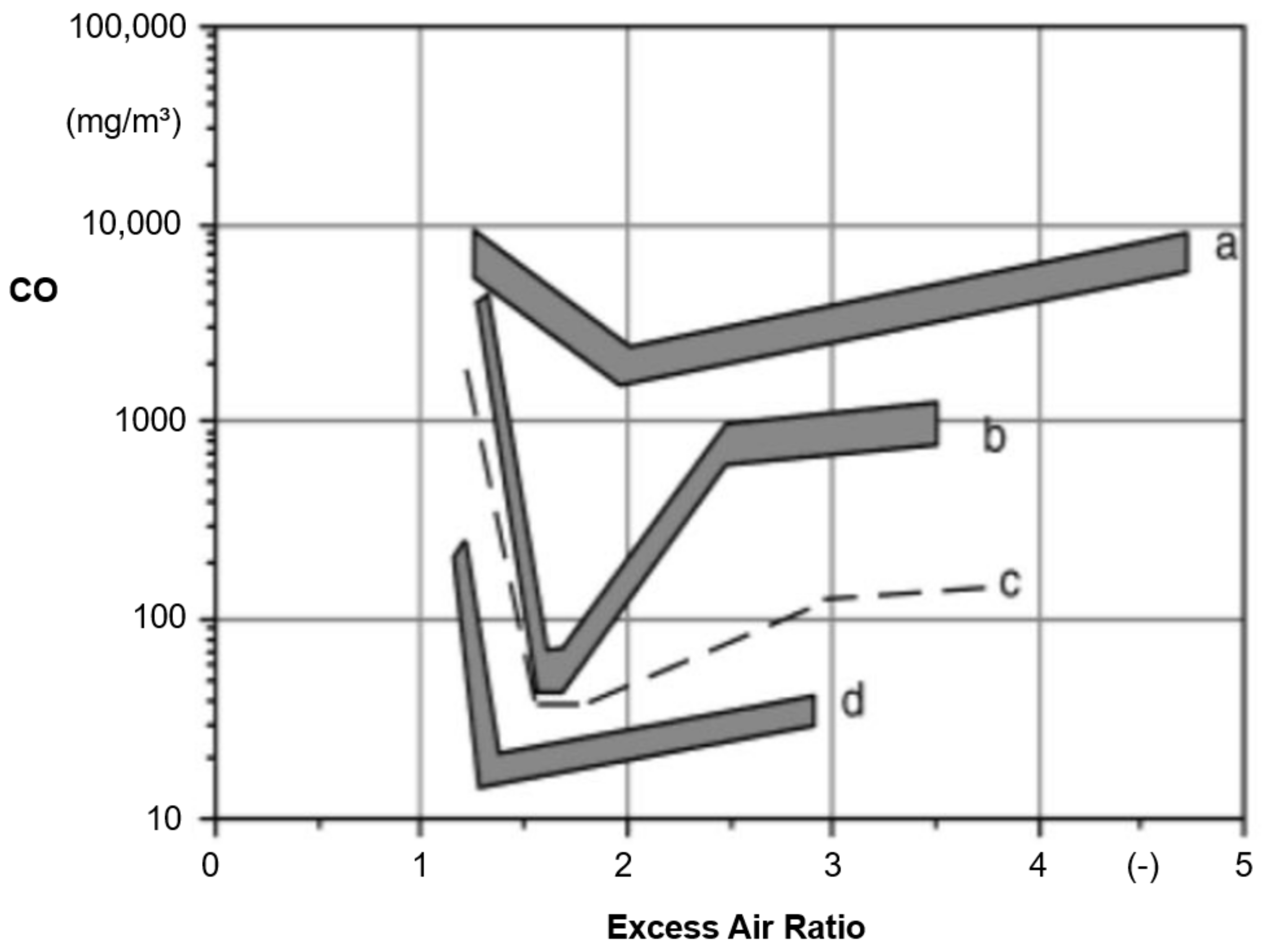
| Stove | Nominal Load | CO * | PM * | 𝜂 |
|---|---|---|---|---|
| Xeoos [56] | 8 kW | 0.05 vol.-% | 22 mg/m³ | 83.6% |
| Xeoos [57] | 5 kW | 0.05 vol.-% | 20 mg/m³ | 83.7% |
| Bionic Fire EVO [58] | 5 kW | 302 mg/m³ | 4 mg/m³ | 86.0% |
3.4. State of the Art of Secondary Measures
3.4.1. Packing Technology (Oxidizing Reactors)
- High specific heat capacity;
- Enhancement of turbulence;
- Rough surface area and adhesive material properties;
- Low flow resistance;
- High mechanical, thermal and chemical resistance.
- Flow area loading ();
- Pressure drops (, ≤ 3Pa);
- Thermal surface loading ();
- Thermal volume loading ().
3.4.2. Catalysts
- Diffusion of reactants/educts (e.g., CO, O2) through the boundary layer (boundary layer diffusion);
- Diffusion of reactants into the pores of the washcoat (pore diffusion);
- Chemisorption of reactants/educts at the active sites;
- Chemical reaction of reactants/educts at the active sites;
- Desorption of products from the active sites;
- Diffusion of products out of the pores of the washcoat (pore diffusion);
- Diffusion of products (e.g., CO2) through the boundary layer into the flue gas flow through the honeycomb cells (boundary layer diffusion).
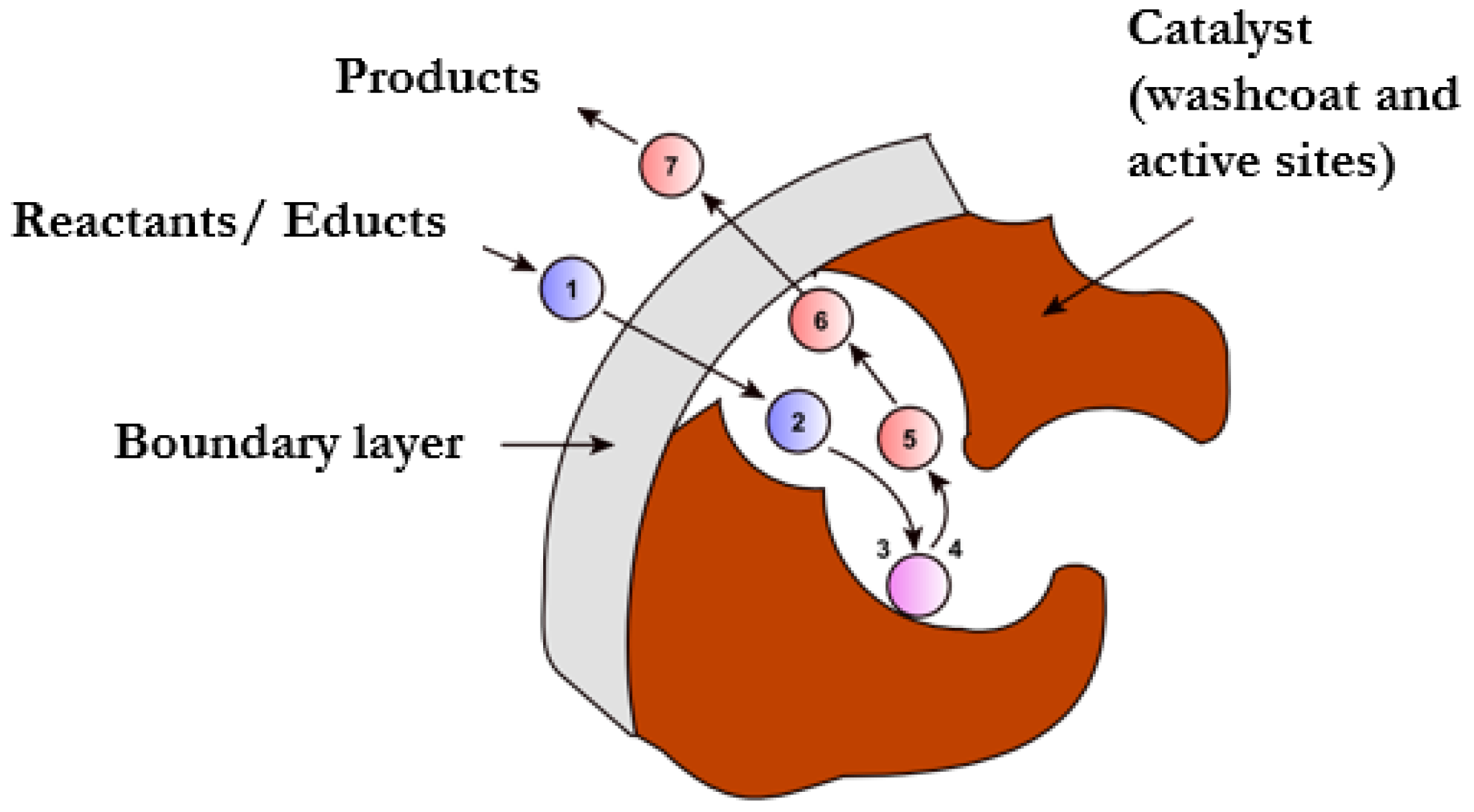
- Temperatures (minimum, maximum, average);
- Pressure drops;
- Bypass according to requirements of respective EN standards, e.g., 3% of sectional area or at least 20 cm² of the flown-through sectional area [67];
- Accessibility for cleaning, maintenance and exchange.
- Chemical deactivation is caused by selective or non-selective poisoning, which results in an inactivation of active sites by gaseous components, e.g., Pb, Zn, P or SO2. Furthermore, leaching is a type of chemical deactivation caused by undesired chemical reactions between gaseous compounds in the flue gas and the active sites of the catalyst, leading to a loss of those sites. Chemical deactivation mechanisms are mostly irreversible. Therefore, the operating conditions and the type of catalyst used must be adjusted, and critical components avoided, e.g., Pb, P, Zn and SO2 for Pt- and Pd-based catalysts;
- Thermal deactivation is caused by the reduction of the surface area of active sites or the porous surface of the washcoat due to sintering processes. Thermal deactivation is also irreversible and can be avoided by the appropriate design and operation of the appliance. In particular, maximum temperature conditions must be considered for the application of certain catalysts;
- Mechanical deactivation is caused by fouling processes, i.e., the deposition of particles on the pores and/or the active sites, or due to attrition, i.e., loss of active sites due to abrasion or mechanically induced crushing. Both mechanisms lead to a decrease of the catalytic conversion efficiency. However, deactivation by fouling is often (at least partially) reversible, e.g., by cleaning the catalyst or by oxidative regeneration of carbonaceous deposits.
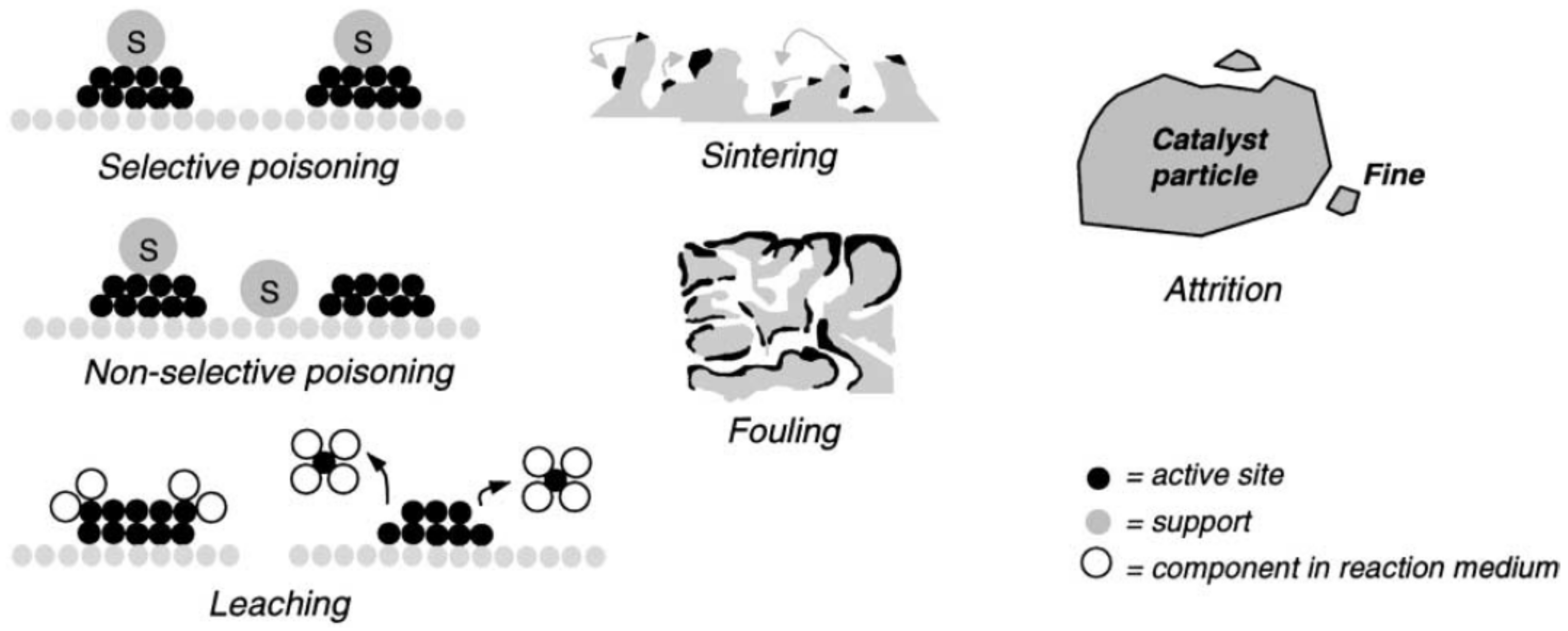
3.4.3. Foamed Ceramic (not Catalytically Coated)
3.4.4. Fabric Baghouse Filters
3.4.5. Electrostatic Precipitator (ESP)
- Avoidance of noise, e.g., due to sparking;
- Avoidance of contamination, e.g., agglomerations in the chimney or release of flakes with particle sizes of about 5 mm;
- Integration or location of ESPs either in the chimney system (ESP is a separate system) or integrated in the room-heating appliance (ESP is part of the stove);
- High voltage in a living space (only relevant for integrated systems);
- Positioning of the electrodes in integrated systems for good accessibility (maintenance/cleaning) and to enable suitable temperature levels during operation;
- Combination of ESPs for PM emission reduction with secondary technologies focusing on gaseous emission reduction, e.g., catalysts.
4. Discussion
4.1. SWOT Analysis
4.2. Limits of Non-Technical Primary Measures
4.3. Limits of Technical-Primary Measures
4.4. Synergies of Primary and Secondary Measures
- Secondary technologies reducing only PM emissions;
- Secondary technologies reducing gaseous and particulate emissions (CO, VOC, PM).
5. Conclusions
Author Contributions
Funding
Data Availability Statement
Acknowledgments
Conflicts of Interest
References
- European Commission, DG TREN. Preparatory Studies for Eco-Design Requirements of EuPs (II)—LOT 15—Solid Fuel Small Combustion Appliances, Task 2: Economic and Market Analysis; European Commission: Strasbourg, France, 2009; pp. 1–47. Available online: https://www.eceee.org/static/media/uploads/site-2/ecodesign/products/solid-fuel-small-combustion-installations/bio-eup-lot-15-task2-final.pdf (accessed on 24 November 2022).
- Karlsson, B.S.; Håkansson, M.; Sjöblom, J.; Ström, H. Light my fire but don’t choke on the smoke: Wellbeing and pollution from fireplace use in Sweden. Energy Res. Soc. Sci. 2020, 69, 101696. [Google Scholar] [CrossRef]
- IEA. World Energy Outlook, Special Report, Energy and Air Pollution. 2016. Available online: https://www.iea.org/reports/energy-and-air-pollution (accessed on 19 May 2022).
- Hartmann, H. Strategies for Reducing the Impact on Air Quality from Residential and Commercial Wood Combustion. IEA Bioenergy-Task 32. In Proceedings of the IEA Bioenergy Triannual Conference: “Bioenergy—A Critical Part of the Path to Carbon Neutrality”, Online, 7 December 2021; Available online: https://www.ieabioenergyconference2021.org/wp-content/uploads/2021/12/11-05_HARTMANN.pdf (accessed on 24 November 2022).
- Sahlberg, A.; Karlsson, B.S.; Sjöblom, J.; Ström, H. Don’t extinguish my fire—Understanding public resistance to a Swedish policy aimed at reducing particle emissions by phasing out old wood stoves. Energy Policy 2022, 167, 113017. [Google Scholar] [CrossRef]
- European Commission. Commission Regulation (EU) 2015/1185 of 24, Implementing Directive 2009/125/EC of the European Parliament and of the Council with regard to ecodesign requirements for solid fuel local space heaters. Off. J. Eur. Union 2015, 193, 1–19. Available online: http://www.eceee.org/static/media/uploads/site-2/ecodesign/products/lot-20-local-room-heating-products/celex-32015r1185-en-txt.pdf (accessed on 24 November 2022).
- Mack, R.; Hartmann, H.; Schön, C. Influence of user behavior on emissions from firewood stoves. In Proceedings of the 27th European Biomass Conference and Exhibition, Lisbon, Portugal, 27–30 May 2019; Available online: https://www.tfz.bayern.de/mam/cms08/festbrennstoffe/dateien/cp_influence_of_user_behaviour_on_emissions_from_firewood_stoves_-_eu_bc_e_lisbon_2019.pdf (accessed on 24 November 2022).
- Mack, R.; Schön, C.; Kuptz, D.; Hartmann, H. Nutzereinflüsse auf das Emissionsverhalten von Kaminöfen—Anzünden, Lufteinstellungen, Brennstoff; Berichte aus dem TFZ, Nr. 61; Technologie- und Förderzentrum im Kompetenzzentrum für Nachwachsende Rohstoffe (TFZ): Straubing, Germany, 2019; p. 109. Available online: https://www.tfz.bayern.de/mam/cms08/festbrennstoffe/dateien/tfz_bericht_61_nutzereinfluesse.pdf (accessed on 24 November 2022).
- Reichert, G.; Schmidl, C. SWOT-Analysis of primary and secondary measures for firewood stoves. In Proceedings of the 30th European Biomass Conference and Exhibition, Virtual Conference, 9–12 May 2022. [Google Scholar]
- Reichert, G.; Hartmann, H.; Haslinger, W.; Oehler, H.; Mack, R.; Schmidl, C.; Schön, C.; Schwabl, M.; Stressler, H.; Sturmlechner, R.; et al. Effect of draught conditions and ignition technique on combustion performance of firewood room heaters. Renew. Energy 2017, 105, 547–560. [Google Scholar] [CrossRef]
- Reichert, G.; Schmidl, C.; Haslinger, W.; Schwabl, M.; Moser, W.; Aigenbauer, S.; Wöhler, M.; Hochenauer, C. Investigation of user behavior and assessment of typical operation mode for different types of firewood room heating appliances in Austria. Renew. Energy 2016, 93, 245–254. [Google Scholar] [CrossRef]
- Wöhler, M.; Andersen, J.S.; Becker, G.; Persson, H.; Reichert, G.; Schön, C.; Schmidl, C.; Jaeger, D.; Pelz, S.K. Investigation of real-life operation of biomass room heating appliances—Results of a European survey. Appl. Energy 2016, 169, 240–249. [Google Scholar] [CrossRef]
- Fachinger, F.; Drewnick, F.; Gieré, R.; Borrmann, S. How the user can influence particulate emissions from residential wood and pellet stoves: Emission factors for different fuels and burning conditions. Atmos. Environ. 2017, 158, 216–226. [Google Scholar] [CrossRef]
- Schieder, W.; Storch, A.; Fischer, D.; Thielen, P.; Zechmeister, A.; Poupa, S.; Wampl, S. Luftschadstoffausstoß von Festbrennstoff-Einzelöfen—Untersuchung des Einflusses von Festbrennstoff-Einzelöfen auf den Ausstoß von Luftschadstoffen; Umweltbundesamt GmbH: Wien, Austria, 2013; p. 368. ISBN 978-3-99004-253-3. Available online: https://www.umweltbundesamt.at/fileadmin/site/publikationen/REP0448.pdf (accessed on 25 November 2022).
- Meyer, N.K. Particulate, black carbon and organic emissions from small-scale residential wood combustion appliances in Switzerland. Biomass Bioenergy 2012, 36, 31–42. [Google Scholar] [CrossRef]
- Schmidl, C.; Luisser, M.; Padouvas, E.; Lasselsberger, L.; Rzaca, M.; Ramirez-Santa Cruz, C.; Handler, M.; Peng, G.; Bauer, H.; Puxbaum, H. Particulate and gaseous emissions from manually and automatically fired small scale combustion systems. Atmos. Environ. 2011, 45, 7443–7454. [Google Scholar] [CrossRef]
- Ozgen, S.; Caserini, S.; Galante, S.; Giugliano, M.; Angelino, E.; Marongiu, A.; Hugony, F.; Migliavacca, G.; Morreale, C. Emission factors from small scale appliances burning wood and pellets. Atmos. Environ. 2014, 94, 144–153. [Google Scholar] [CrossRef]
- Schön, C.; Hartmann, H. Log wood combustion in stoves—Influence on emissions and efficiency. In Proceedings of the 20th European Biomass Conference and Exhibition, Milan, Italy, 18–22 June 2012; Available online: https://www.tfz.bayern.de/mam/cms08/festbrennstoffe/dateien/cp_log_wood_combustion_in_stoves_%E2%80%93_influence_on_emissions_and_efficiency_-_eu_bc_e_milan_2012.pdf (accessed on 25 November 2022).
- Schön, C.; Hartmann, H. Nutzer- und Brennstoffeinflüsse auf Feinstaubemissionen aus Kleinfeuerungen; Berichte aus dem TFZ, Nr. 36; Technologie- und Förderzentrum im Kompetenzzentrum für Nachwachsende Rohstoffe (TFZ): Straubing, Germany, 2014; p. 109. Available online: https://www.tfz.bayern.de/mam/cms08/festbrennstoffe/dateien/36_bericht.pdf (accessed on 25 November 2022).
- Nord-Larsen, T.; Bergstedt, A.; Farver, O.; Heding, N. Drying of firewood—The effect of harvesting time, tree species and shelter of stacked wood. Biomass Bioenergy 2011, 35, 2993–2998. [Google Scholar] [CrossRef]
- Hartmann, H.; Schön, C.; Turowski, P.; Obernberger, I.; Biedemann, F.; Bäfver, L.; Finnan, J. Low Emission Operation Manual for Chimney Stove Users; Report within the Scope of the ERA-NET Project “FutureBio Tec”; Bioenergy: Graz, Österreich, 2012; Available online: https://www.tfz.bayern.de/mam/cms08/festbrennstoffe/dateien/futurebiotec-low_emission_operation_manual_for_chimney_stove_users.pdf (accessed on 28 November 2022).
- Spitzer, P.; Enzinger, G.; Fankhauser, G.; Fritz, W.; Golja, F.; Stiglbrunner, R. Emissionsfaktoren für Feste Brennstoffe, Endbericht; Johanneum Research: Graz, Austria, 1998; p. 36. Available online: https://silo.tips/download/endbericht-emissionsfaktoren-fr-feste-brennstoffe-j-spitzer-p-enzinger-g-fankhau (accessed on 25 November 2022).
- Brandelet, B.; Rose, C.; Rogaume, C.; Rogaume, Y. Impact of ignition technique on total emissions of a firewood stove. Biomass Bioenergy 2018, 108, 15–24. [Google Scholar] [CrossRef]
- Nussbaumer, T.; Doberer, A.; Klippel, N.; Bühler, R.; Vock, W. Influence of ignition and operation type on particle emissions from residential wood combustion. In Proceedings of the 16th European Biomass Conference and Exhibition, Valencia, Spain, 2–6 June 2008; Available online: http://www.verenum.ch/Publikationen/Biomass-Conf9.5.pdf (accessed on 25 November 2022).
- Mack, R.; Kuptz, D.; Schön, C.; Hartmann, H. Optimierungspotenziale bei Kaminöfen; Berichte aus dem TFZ, Nr. 57; Technologie- und Förderzentrum im Kompetenzzentrum für Nachwachsende Rohstoffe (TFZ): Straubing, Germany, 2018; p. 116. Available online: https://www.tfz.bayern.de/publikationen/berichte/234589/index.php (accessed on 25 November 2022).
- Sturmlechner, R.; Stressler, H.; Schwabl, M.; Reichert, G.; Carlon, E.; Haslinger, W.; Schmidl, C.; Weissinger, A. Emission factor assessment for two firewood stoves. WIT Trans. Ecol. Environ. 2017, 211, 171–182. [Google Scholar] [CrossRef] [Green Version]
- BMK-Bundesministerium Klimaschutz, Umwelt, Energie, Mobilität, Innovation und Technologie, Richtig Heizen mit Holz. Available online: https://www.bmk.gv.at/dam/jcr:16f8e912-bde5-4929-b6af-03f0f2e6cd56/Folder_richtig_heizen_mit_Holz.pdf (accessed on 25 November 2022).
- Hartmann, H.; Schön, C.; Turowski, P. Richtig heizen. Der Betrieb von Kaminöfen; TFZ-Wissen, Nr.1; Technologie- und Förderzentrum im Kompetenzzentrum für Nachwachsende Rohstoffe (TFZ): Straubing, Germany, 2015; p. 31. Available online: http://www.tfz.bayern.de/mam/cms08/festbrennstoffe/dateien/tfz_wissen_b_web_s.pdf (accessed on 25 November 2022).
- HKI-Industrieverband Haus-, Heiz- und Küchentechnik e.V., Heizen mit Holz—So geht’s Richtig. Available online: https://www.youtube.com/watch?v=l9HeeoAIEnk (accessed on 25 November 2022).
- Umweltbundesamt GmbH. BMK-Bundesministerium Klimaschutz, Umwelt, Energie, Mobilität, Innovation und Technologie (Ed.), Richtig heizen. Available online: https://www.richtigheizen.at/ (accessed on 25 November 2022).
- CleanAir—R&D Project. Available online: https://www.best-research.eu/de/kompetenzbereiche/verbrennung/projekte/view/615 (accessed on 25 November 2022).
- Kirchsteiger, B.; Kubik, F.; Sturmlechner, R.; Stressler, H.; Schwabl, M.; Kistler, M.; Kasper-Giebl, A. Real-life emissions from residential wood combustion in Austria: From TSP emissions to PAH emission profiles, diagnostic ratios and toxic risk assessment. Atmos. Pollut. Res. 2021, 12, 101127. [Google Scholar] [CrossRef]
- Schwabl, M. Raising awareness and changing behaviour with the traveling combustion education—The CleanAir II project. In Proceedings of the IEA Bioenergy Triannual Conference: “Bioenergy—A Critical Part of the Path to Carbon Neutrality”, Online, 7 December 2021; Available online: https://www.ieabioenergyconference2021.org/wp-content/uploads/2021/12/11-04_SCHWABL.pdf (accessed on 25 November 2022).
- beReal—R&D Project. Advanced Testing Methods for Better Real Life Performance of Biomass Heating Appliances. Available online: http://www.bereal-project.eu/ (accessed on 25 November 2022).
- Reichert, G.; Sturmlechner, R.; Stressler, H.; Schwabl, M.; Schmidl, C.; Oehler, H.; MACK, R.; Hartmann, H. Deliverable D3.3-Final Report: Definition of Suitable Measurement Methods and Advanced Type Testing Procedure for Real Life Conditions, 30. September 2016, 35p. Available online: http://www.bereal-project.eu/uploads/1/3/4/9/13495461/d3.3_definition_of_suitable_measurement_methods_final_1.pdf (accessed on 25 November 2022).
- Rönnback, M.; Persson, H.; Jespersen, M.G.; Jensen, J.H. Deliverable D7.1—Documentation and Evaluation of Field Data Demonstration 30 September 2016, 36 p. Available online: http://www.bereal-project.eu/uploads/1/3/4/9/13495461/d7.1_documentation_and_evaluation_of_field_data_demonstration_final_1.pdf (accessed on 25 November 2022).
- Gaderer, M.; Gölles, M.; Hartmann, H.; Hofbauer, H.; Kaltschmitt, M.; Keil, F.; Nussbaumer, T.; Spliethoff, H. Direkte thermo-chemische Umwandlung (Verbrennung). In Energie aus Biomasse. Grundlagen, Techniken und Verfahren, 3rd ed.; Kaltschmitt, M., Hartmann, H., Hofbauer, H., Eds.; Springer: Berlin/Heidelberg, Germany, 2016. [Google Scholar] [CrossRef]
- Warming-Jespersen, M.G. Technical Guidelines for Design of low Emission Stoves; IEA Task 32, IEA Webinar 06.05.2021. Available online: https://task32.ieabioenergy.com/wp-content/uploads/sites/2/2020/06/02_Technical-guidelines-for-design-of-low-emission-stoves-22-01-2020.pdf (accessed on 25 November 2022).
- Schwingruber, P.; Horat, P.; Nussbaumer, T. Optimierung der Mischung von Sekundärluft und Gasen Thomas Nussbaumer (Hrsg.). In 13. Holzenergie-Symposium: Entwicklungen für Wärme, Kraft und Fernwärme aus Holz. Tagung an der ETH Zürich am 12. September 2014; Verenum: Zürich, Switzerland, 2014; ISBN 3-908705-25-8. [Google Scholar]
- Brunner, T.; Obernberger, I.; Scharler, R. Primary measures for low-emission residential wood combustion – comparison of old with optimized modern systems. In Proceedings of the 17th European Biomass Conference & Exhibition, ETA-renewable Energies, Hamburg, Germany, 29 June–3 July 2009; Available online: https://www.bios-bioenergy.at/images/bios/downloads/publikationen/Pellets/091-Paper-Brunner-Primary-measures-for-low-emission-wood-combustion-EUBCE2009.pdf (accessed on 25 November 2022).
- Scharler, R.; Gruber, T.; Ehrenhöfer, A.; Kelz, J.; Bardar, R.M.; Bauer, T.; Hochenauer, C.; Anca-Couce, A. Transient CFD simulation of wood log combustion in stoves. Renew. Energy 2020, 145, 651–662. [Google Scholar] [CrossRef]
- Virén, A.; Lamberg, H.; Tissari, J.; Sippula, O.; Jokiniemi, J.; Hartmann, H.; Schön, C. Guidelines for Low Emission Chimney Stoves Design; Report within the Scope of the ERA-NET Project “FutureBio Tec”; Bioenergy: Graz, Österreich, 2012; Available online: https://www.researchgate.net/publication/326316692_Guideline_for_Low_Emission_Chimney_Stove_Design (accessed on 25 November 2022).
- Österreichischer Kachelofenverband. Technischer Ausschuss, UmweltPlus Brennraum; Merkblatt 10; Ausgabe: Wien, Österreich, 2018; Available online: https://docplayer.org/168903887-Umweltplus-brennraum.html (accessed on 25 November 2022).
- ÖNORM EN 16510-1:2018 12 01; Residential Solid Fuel Burning Appliances—Part 1: General Requirements and Test Methods. Austrian Standards: Vienna, Austria, 2018.
- ZUK 130 DW—Zugbegrenzer. Available online: https://www.raab-gruppe.de/portfolio-items/zugbegrenzer-zuk-130-dw/#tab-b63621274509f7f9978 (accessed on 25 November 2022).
- ORTNER GmbH. Das Ortner Berechnungsprogramm, Anleitung. Juni 2020. Available online: https://berechnungsprogramm.ortner-cc.at/ (accessed on 25 November 2022).
- Reichert, G. Primary- and secondary measures for manually fired stoves—An overview. In Proceedings of the 6th Central European Biomass Conference, Graz, Austria, 24 December 2019–22 January 2020; Available online: https://www.best-research.eu/files/publications/pdf/CleanAirII_Primary_Secondary_Measures_200121_GabrielReichert.pdf (accessed on 25 November 2022).
- Illerup, J.; Mandl, C.; Obernberger, I.; Mack, R.; Hartmann, H.; Schüssler, I.; Furborg, J.; Volz, F. Guidelines for Automated Control Systems for Stoves; Report within the Scope of the ERA-NET Project “Woodstove2020”. Development of Next Generation and Clean Wood Stoves, July 2017 Bios Bioenergiesysteme. Available online: https://backend.orbit.dtu.dk/ws/files/140796742/Guidelines_Control_final.pdf (accessed on 25 November 2022).
- Energie-Experten. Overview about Automatic Combustion Air Regulation Systems (Selection). Available online: https://www.energie-experten.org/heizung/ofen/ofentechnik/abbrandsteuerung (accessed on 19 May 2022).
- Hwam, Wiking® Automatic™. Available online: https://hwam.com/advantages/wiking-automatic (accessed on 25 November 2022).
- Hwam, Hwam® Smartcontroltm. Available online: https://hwam.com/advantages/hwam-smart-control (accessed on 25 November 2022).
- Illerup, J.B.; Hansen, B.B.; Lin, W.; Nickelsen, J.; Dam Johansen, K. Intelligent heat system—High-Energy efficient wood stoves with low emissions. In Proceedings of the Seminar on Real-World Emissions from Residential Wood Combustion, Copenhagen, Denmark, 3 December 2015; p. 24. Available online: https://envs2.au.dk/Projekter/Seminar_RealWorldEmissions/Illerup_RealWorldEmissions.pdf (accessed on 19 May 2022).
- Illerup, J.B.; Hansen, B.B.; Lin, W.; Nickelsen, J.; Pedersen, V.H.; Eskerod, B.; Dam-Johansen, K. Performance of an automatically controlled wood stove: Thermal efficiency and carbon monoxide emissions. Renew. Energy 2020, 151, 640–647. [Google Scholar] [CrossRef]
- Nussbaumer, T. Combustion and Co-combustion of Biomass: Fundamentals, Technologies, and primary Measures for Emission Reduction. Energy Fuels 2003, 17, 1510–1521. Available online: http://www.verenum.ch/Publikationen/comb%20_cocomb.pdf (accessed on 25 November 2022). [CrossRef]
- Wiest, W. Sturzbrandfeuerung für Kaminöfen—Technik und Anwendungen Thomas Nussbaumer (Hrsg.). In 13. Holzenergie-Symposium: Entwicklungen für Wärme, Kraft und Fernwärme aus Holz. Tagung an der ETH Zürich am 12. September 2014; Verenum: Zürich, Switzerland, 2014; ISBN 3-908705-25-8. [Google Scholar]
- Kaminofen xeoos 8 kW, Technical Specifications. Available online: https://www.xeoos.de/fileadmin/daten/downloads/technik/neu/Leistungserklaerung_x8_140409.pdf (accessed on 25 November 2022).
- Kaminofen xeoos 5 kW, Technical Specifications. Available online: https://www.xeoos.de/fileadmin/daten/downloads/technik/neu/Leistungserklaerung_x5_140409.pdf (accessed on 25 November 2022).
- Attika, Bionic Fire 4,6 kW, Technical Specifications. Available online: https://pass.attika-intern.ch/ccp/files/121/BIONIC_FIRE_EVO_Datenblatt.pdf (accessed on 25 November 2022).
- Nussbaumer, T. Staubabscheidesysteme—Eine Einführung, BAFU-Fachtagung Holzverbrennung und Feinstaub, Bern 08.11.2011. Available online: https://www.bafu.admin.ch/dam/bafu/de/dokumente/luft/fachinfo-daten/staubabscheidesysteme-eineeinfuehrung.pdf.download.pdf/staubabscheidesysteme-eineeinfuehrung.pdf (accessed on 25 November 2022).
- Aleysa, M.; Leistner, P. Verbesserung des Verbrennungs- und Emissionsverhaltens in Biomassebetriebenen Einzelraumfeuerungsanlagen durch den Einsatz Spezieller Einbauten; Abschlussbericht über ein Forschungsprojekt gefördert von der Fachagentur für Nachwachsende Rohstoffe (FKZ: 13NR104); Fraunhofer—Institut für Bauphysik IBP: Stuttgart, Germany, 2016; Available online: http://docplayer.org/113343304-Verbesserung-des-verbrennungs-und-emissionsverhaltens-in-biomassebetriebenen-einzelraumfeuerungsanlagen-durch-den-einsatz-spezieller-einbauten.html (accessed on 25 November 2022).
- Aleysa, M. Packing technology for emission reduction in wood-burning stoves and biomass boilers. In Thomas Nussbaumer (Hrsg.), 15. Holzenergie-Symposium: Netzintegration, Vorschriften und Feuerungstechnik; Tagung an der ETH Zürich am 14. September 2018; Verenum: Zürich, Switzerland, 2018; ISBN 3-908705-36-3. Available online: http://www.holzenergie-symposium.ch/Dokumente/Tgband15HES.pdf (accessed on 25 November 2022).
- PALL-RINGE, Evaluation of Costs. Available online: https://de.made-in-china.com/tag_search_product/Pall-Rings_eiueron_1.html (accessed on 29 November 2022).
- File:CatalysisScheme.png. Copyright 2008, Attribution: No Machine-Readable Author Provided. Smokefoot Assumed (Based on Copyright Claims)., Public Domain, via Wikimedia Commons. Available online: https://commons.wikimedia.org/wiki/File:CatalysisScheme.png (accessed on 25 November 2022).
- Wöhler, M.; Jaeger, D.; Pelz, S.K.; Thorwarth, H. Potential of Integrated Emissions Reduction Systems in a Firewood Stove under Real Life Operation Conditions. Energy Fuels 2017, 31, 7562–7571. [Google Scholar] [CrossRef] [Green Version]
- VDI 3476-1. Guideline: Waste gas cleaning-methods of catalytic waste Gas cleaning. In Fundamentals, Kommission Reinhaltung der Luft im VDI und DIN—Normenausschuss KRdL; Beuth GmbH: Berlin, Germany, 2005; pp. 2–25. [Google Scholar]
- Mattern, R. Heterogene Katalyse, Prozessschritte, 15 August. 2010. Available online: https://commons.wikimedia.org/wiki/File:Heterogene_Katalyse_2.svg (accessed on 25 November 2022).
- BLUEFIRE GmbH. Instruction Manual Catalyst. Available online: https://blue-fire.org/wp-content/uploads/2021/07/Betriebsanleitung-Blue-Fire-Katalysator-en4.pdf (accessed on 25 November 2022).
- Reichert, G.; Schmidl, C.; Haslinger, W.; Stressler, H.; Sturmlechner, R.; Schwabl, M.; Wöhler, M.; Hochenauer, C. Impact of oxidizing honeycomb catalysts integrated in firewood stoves on emissions under real-life operating conditions. Fuel Process. Technol. 2018, 177, 109–118. [Google Scholar] [CrossRef]
- Reichert, G.; Schmidl, C.; Haslinger, W.; Stressler, H.; Sturmlechner, R.; Schwabl, M.; Wöhler, M.; Hochenauer, C. Catalytic efficiency of oxidizing honeycomb catalysts integrated in firewood stoves evaluated by a novel measuring methodology under real-life operating conditions. Renew. Energy 2018, 117, 300–313. [Google Scholar] [CrossRef]
- Reichert, G.; Schmidl, C.; Haslinger, W.; Stressler, H.; Sturmlechner, R.; Schwabl, M.; Wöhler, M.; Hochenauer, C. Long term durability and safety aspects of oxidizing honeycomb catalysts integrated in firewood stoves. Biomass Bioenergy 2017, 105, 428–442. [Google Scholar] [CrossRef]
- Estimation of Costs (In Relation to Products Used in the Car Sector). Available online: https://werkstatt-kosten.net/katalysator-kosten/ (accessed on 25 November 2022).
- Moulijn, J.A.; Van Diepen, A.E.; Kapteijn, F. Catalyst deactivation: Is it predictable? What to do? Appl. Catal. A Gen. 2001, 212, 3–16. [Google Scholar] [CrossRef]
- Bartholomew, C.H. Mechanisms of catalyst deactivation. Appl. Catal. Gen. 2001, 2012, 17–60. [Google Scholar] [CrossRef]
- Costs of Foamed Ceramics (Not Catalytical Coated). Available online: https://www.schamotte-shop.de/feinstaub-russfilter-350x350x30mm.html?gclid=EAIaIQobChMItd_6xZOk8wIV1eF3Ch30iwjhEAQYBSABEgJpn_D_BwE (accessed on 25 November 2022).
- Xyloclean, R&D project. Available online: https://heig-vd.ch/rad/instituts/igt/projets/xyloclean (accessed on 25 November 2022).
- Roppa, J.; Roethlisbergerb, R.P.; Rothc, S.; Bourgeoisd, J.P. XYLOCLEAN: Combustion Regulation and Treatment of Smoke from a wood stove. In Proceedings of the 28th International Conference on Efficiency, Cost, Optimization, Simulation and Environmental Impact of Energy Systems, Pau, France, 30 June–3 July 2015; Available online: https://heig-vd.ch/docs/default-source/doc-institut-igt/xylocleani_publication_ecos2015.pdf?sfvrsn=608972e5_0 (accessed on 25 November 2022).
- Baillifard, M.-A.; Ropp, J. Wood log combustion and flue gas after treatment HEIG-VD. DBFZ Deutsches Biomasseforschungszentrum gemeinnützige GmbH (Hrsg.); In 12. Fachgespräch—Partikelabscheider in häuslichen Feuerungen; DBFZ: Leipzig, Germany, 2021. [Google Scholar]
- Kfzteile 24, Costs of Particulate Filters (Cars). Available online: https://www.kfzteile24.at/kategorie/ersatzteile-verschleissteile/abgasanlage/russ-partikelfilter (accessed on 19 May 2022).
- Motointegrator. Rußpartikelfilter—Funktion, Reinigung und Reparaturkosten. 2020. Available online: https://www.motointegrator.de/blog/russpartikelfilter-funktion-reinigung-und-reparaturkosten/ (accessed on 25 November 2022).
- Strauss, K. Kraftwerkstechnik zur Nutzung Fossiler, 7th ed.; Nuklearer und Regenerativer Energiequellen; Springer Vieweg: Berlin, Germany, 2016. [Google Scholar] [CrossRef]
- Lauber, A. Charakterisierung der Partikelarten aus der Holzverbrennung und Eigenschaften in Elektroabscheidern, Thomas Nussbaumer (Hrsg.). In 11. Holzenergie-Symposium: Potenzial zur Holzenergie-Nutzung. Tagung an der ETH Zürich am 17. September 2010; Verenum: Zürich, Switzerland, 2010; ISBN 3-908705-21-5. [Google Scholar]
- Kiener, S.; Turowski, P.; Hartmann, H.; Schmoekel, G. Bewertung Kostengünstiger Staubabscheider für Einzelfeuerstätten und Zentralheizungskessel; Berichte aus dem TFZ, Nr. 23; Technologie- und Förderzentrum im Kompetenzzentrum für Nachwachsende Rohstoffe (TFZ): Straubing, Germany, 2010; p. 144. Available online: https://www.tfz.bayern.de/mam/cms08/festbrennstoffe/dateien/23_bericht.pdf (accessed on 25 November 2022).
- Wüest, J. Zehn Jahre grundlegende Erfahrungen mit Partikel, Messen und Abscheidern Deutsches Biomasseforschungszentrum gemeinnützige GmbH (Hrsg.). In 12. Fachgespräch—Partikelabscheider in Häuslichen Feuerungen; DBFZ: Leipzig, Germany, 2021. [Google Scholar]
- Zotter, P.; Lauber, A.; Nussbaumer, T. Monitoring des Praxisbetriebs von Elektroabscheidern bei sieben Kleinfeuerungen über zwei Heizperioden. In 12. Fachgespräch—Partikelabscheider in Häuslichen Feuerungen; AG, DBFZ Deutsches Biomasseforschungszentrum gemeinnützige GmbH (Hrsg.); Verenum: Zurich, Switzerland.
- Lauber, A.; Nussbaumer, T. Erfolgskontrolle zum Pilotprojekt Feinstaubabscheider im Misox; Schlussbericht: Verenum, Zürich, 2019; Available online: https://www.gr.ch/DE/institutionen/verwaltung/ekud/anu/ANU_Dokumente/ANU-409-95d_Schlussbericht_2019_Pilotprojekt_Misox.pdf (accessed on 25 November 2022).
- OekoSolve AG, Costs OekoTube-Outside. Available online: https://oekosolve.com/produkte/feinstaubfilter-fuer-wohnzimmerfeuerungen/feinstaubfilter-oekotube/ (accessed on 25 November 2022).
- KUTZNER+WEBER, Preis auf Ofenexperte.de für den E-Abscheider „Airjekt 1“. Available online: https://www.ofenexperte.de/zubehoer/feinstaub-partikelabscheider/13889/feinstaubpartikelabscheider-airjekt-1-basic-zur-montage-im-innenbereich (accessed on 25 November 2022).
- Reichert, G.; Schmidl, C. Advanced Test Methods for Firewood Stoves—Report on Consequences of Real-Life Operation on Stove Performance; IEA Bioenergy Task 32; IEA Bioenergy: Wieselburg, Austria, 2018; Available online: https://www.ieabioenergy.com/wp-content/uploads/2018/11/IEA_Bioenergy_Task32_Test-Methods.pdf (accessed on 25 November 2022).
- Hartmann, I.; Tebert, C. The new Blue Angel ecolabel certification method for firewood stoves. In Proceedings of the Central European Biomass Conference 2020 Workshop IEA Task 32, Graz, Austria, 23 January 2020; Available online: https://task32.ieabioenergy.com/wp-content/uploads/sites/24/2020/06/04_Blue-Angel-Stoves.pdf (accessed on 25 November 2022).
- Nussbaumer, T. Introduction to Biomass Combustion and Pollutant Reduction in Wood Stoves and Boilers; IEA Webinar 06.05.2021; IEA Bioenergy: Wieselburg, Austria, 2021; Available online: https://www.ieabioenergy.com/wp-content/uploads/2021/05/Nussbaumer-2021_05_06_IEA-Webinar.pdf (accessed on 25 November 2022).
- Baranowski, T. Unser Beitrag zum Umweltschutz! Zero Emission Now! In 12. Fachgespräch—Partikelabscheider in Häuslichen Feuerungen; DBFZ: Leipzig, Germany, 2021. [Google Scholar]
- Kramb, J.H. Der Schräder PTI (Particulate Trap Inside) für Kesselleistungen bis 50 kW und ein Ausblick auf die Kombination schwenkbarer Katalysatoren mit Partikelabscheider PTI als Ofenaufsatz, Schräder Abgastechnologie. In 12. Fachgespräch—Partikelabscheider in Häuslichen Feuerungen; DBFZ: Leipzig, Germany, 2021. [Google Scholar]




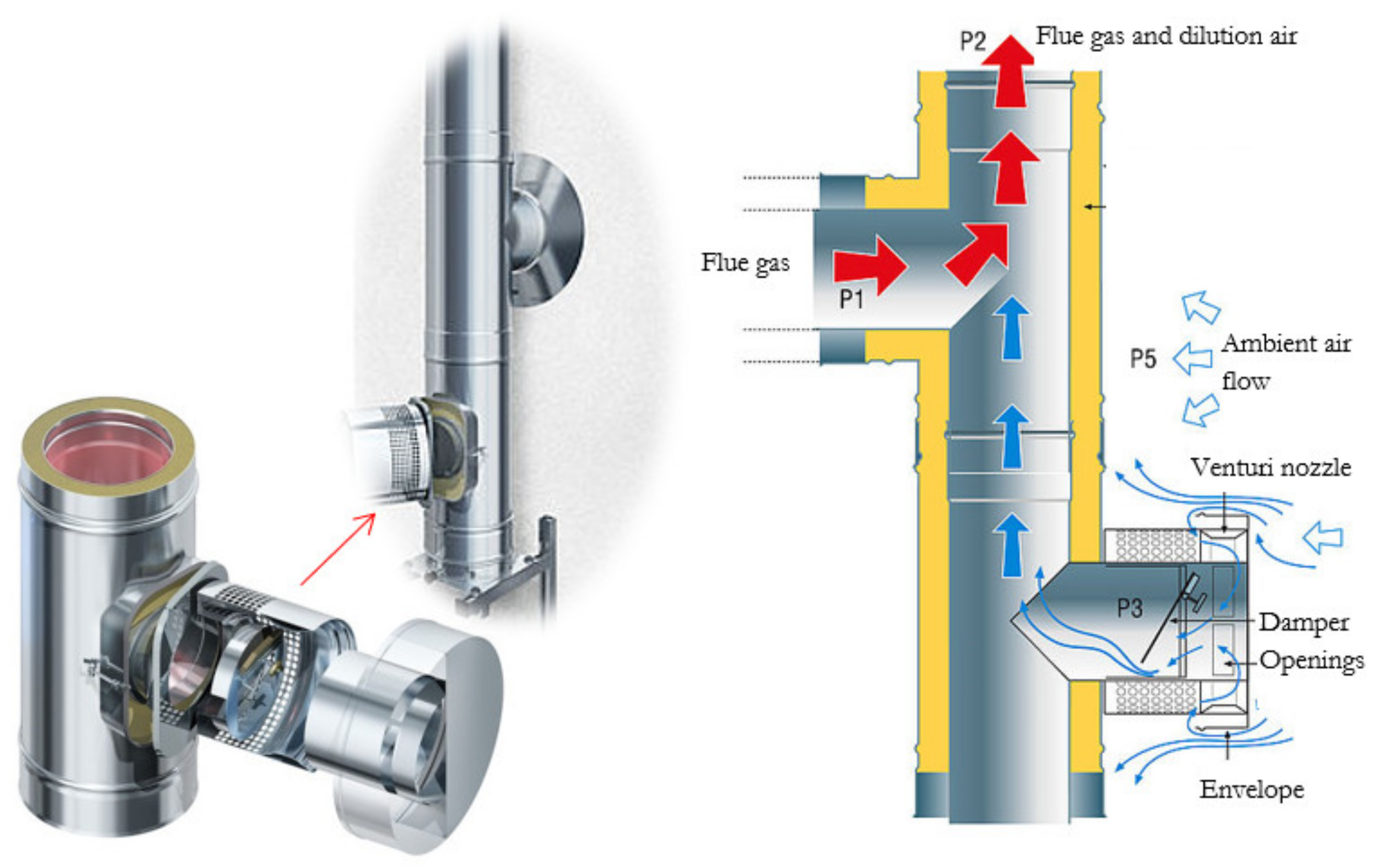
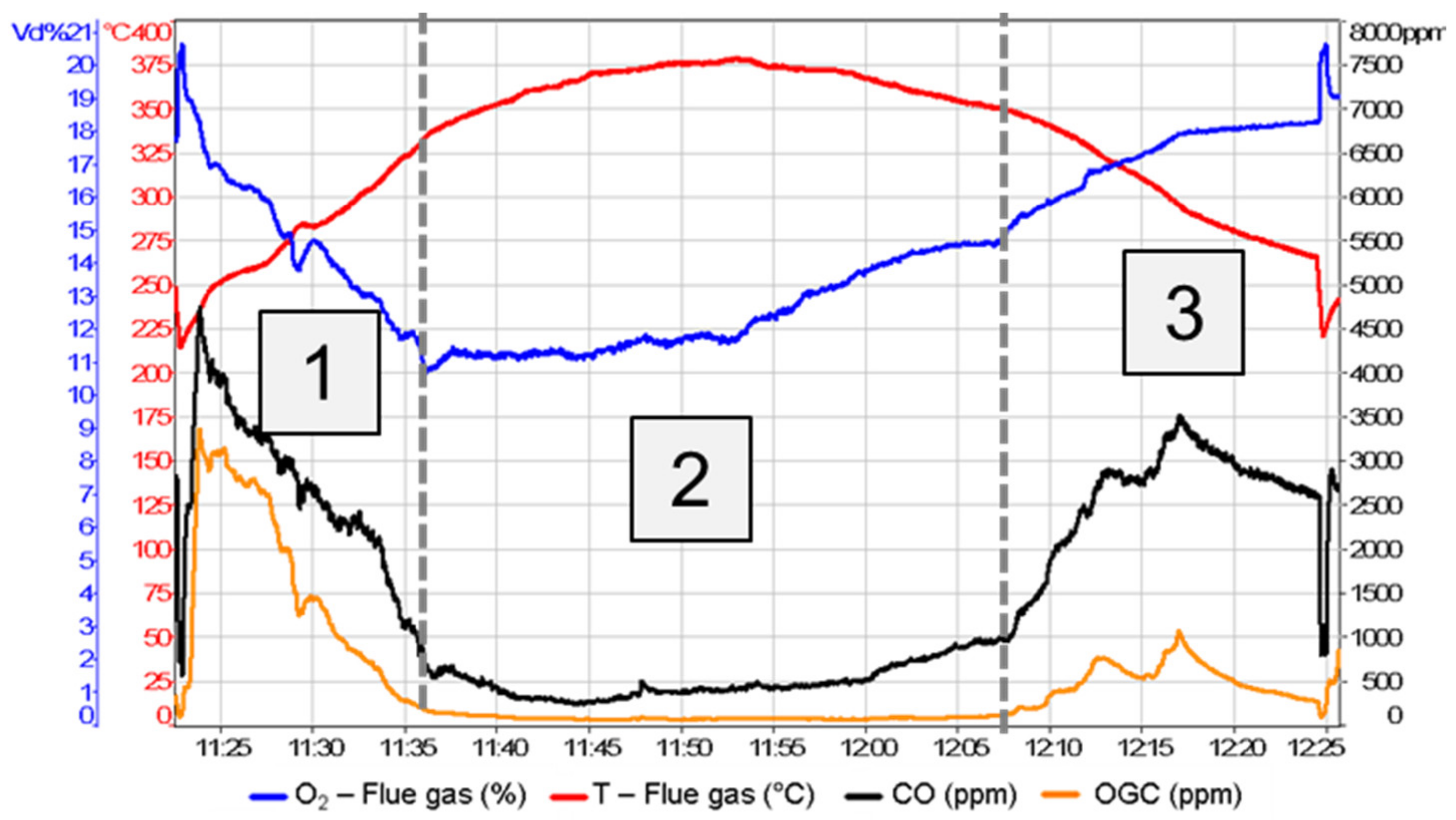

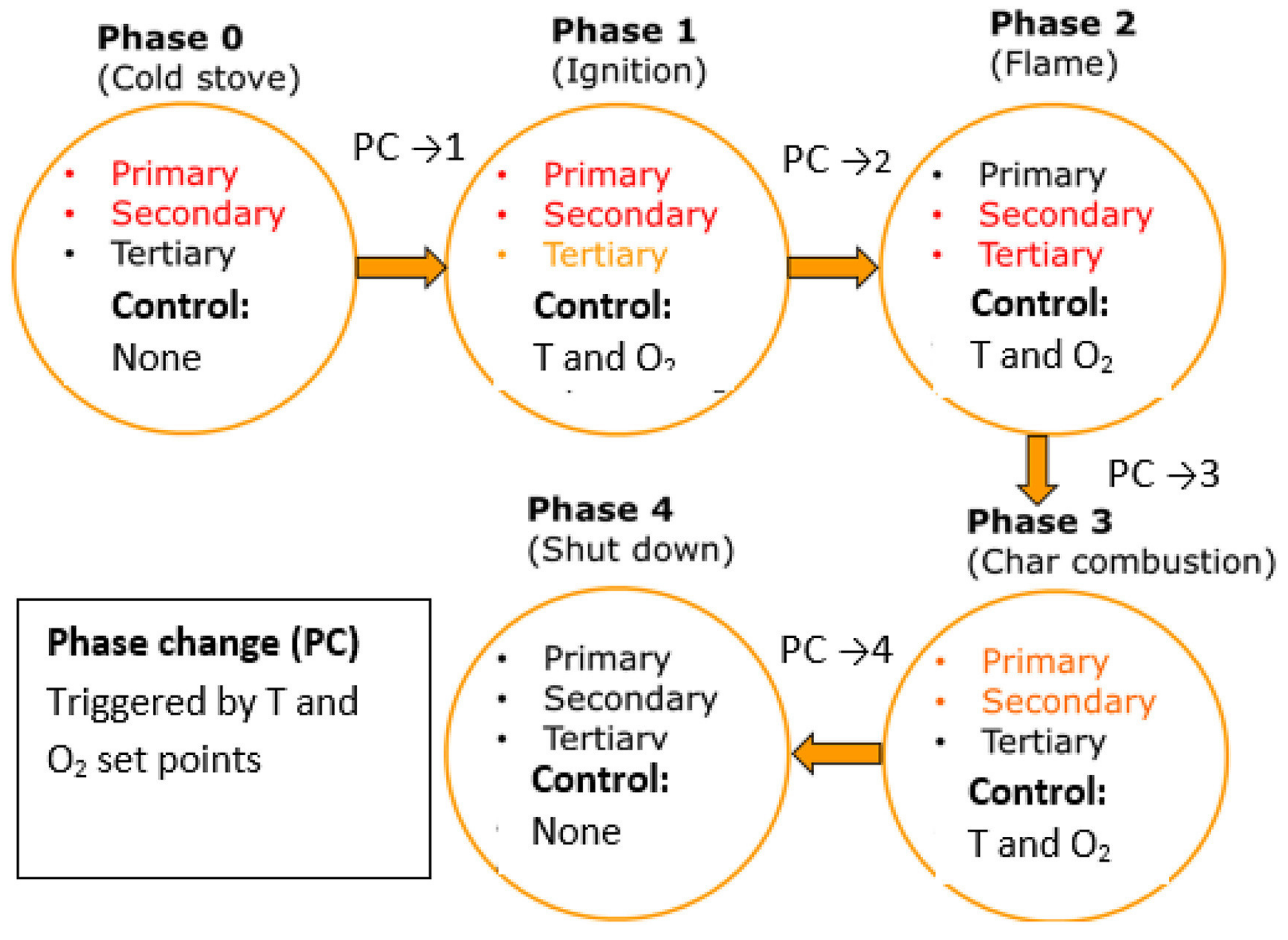


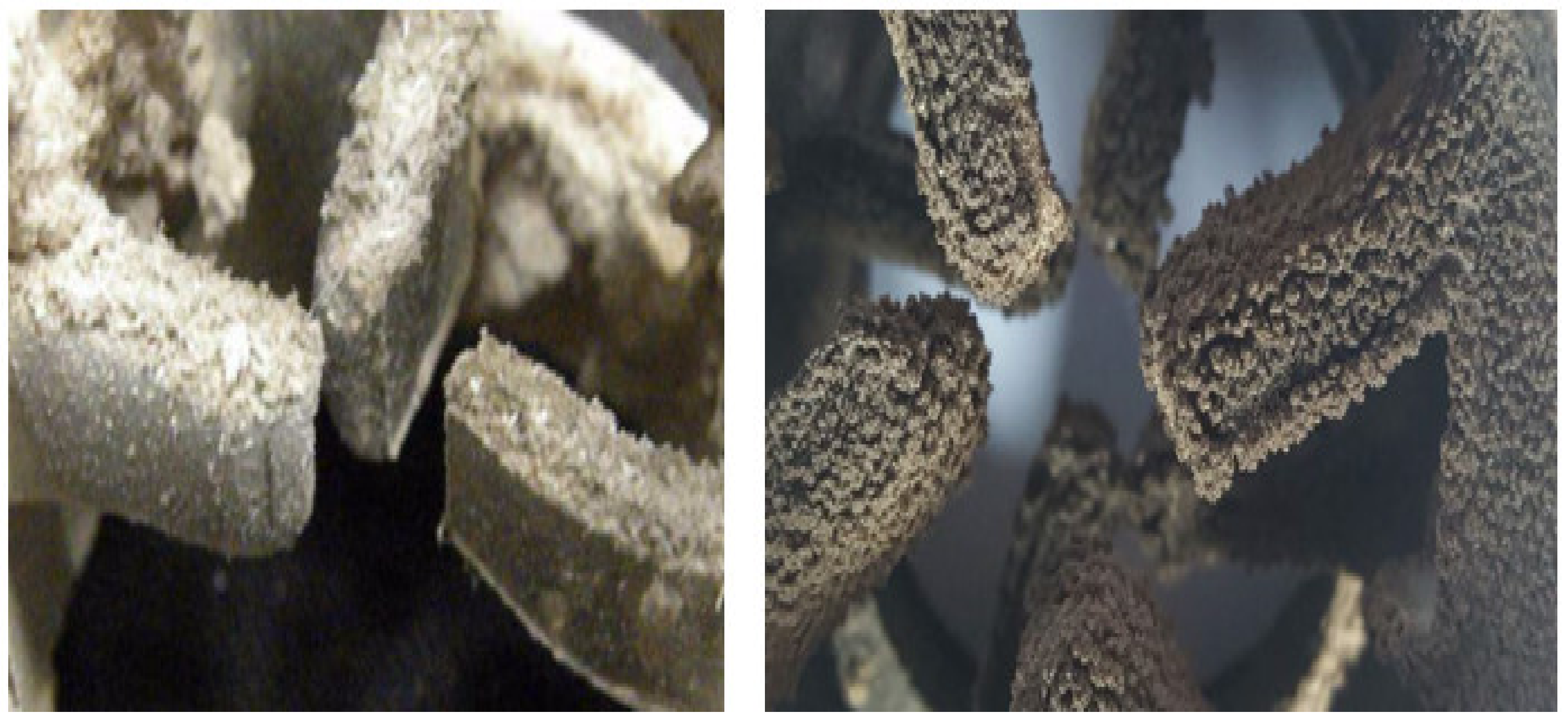

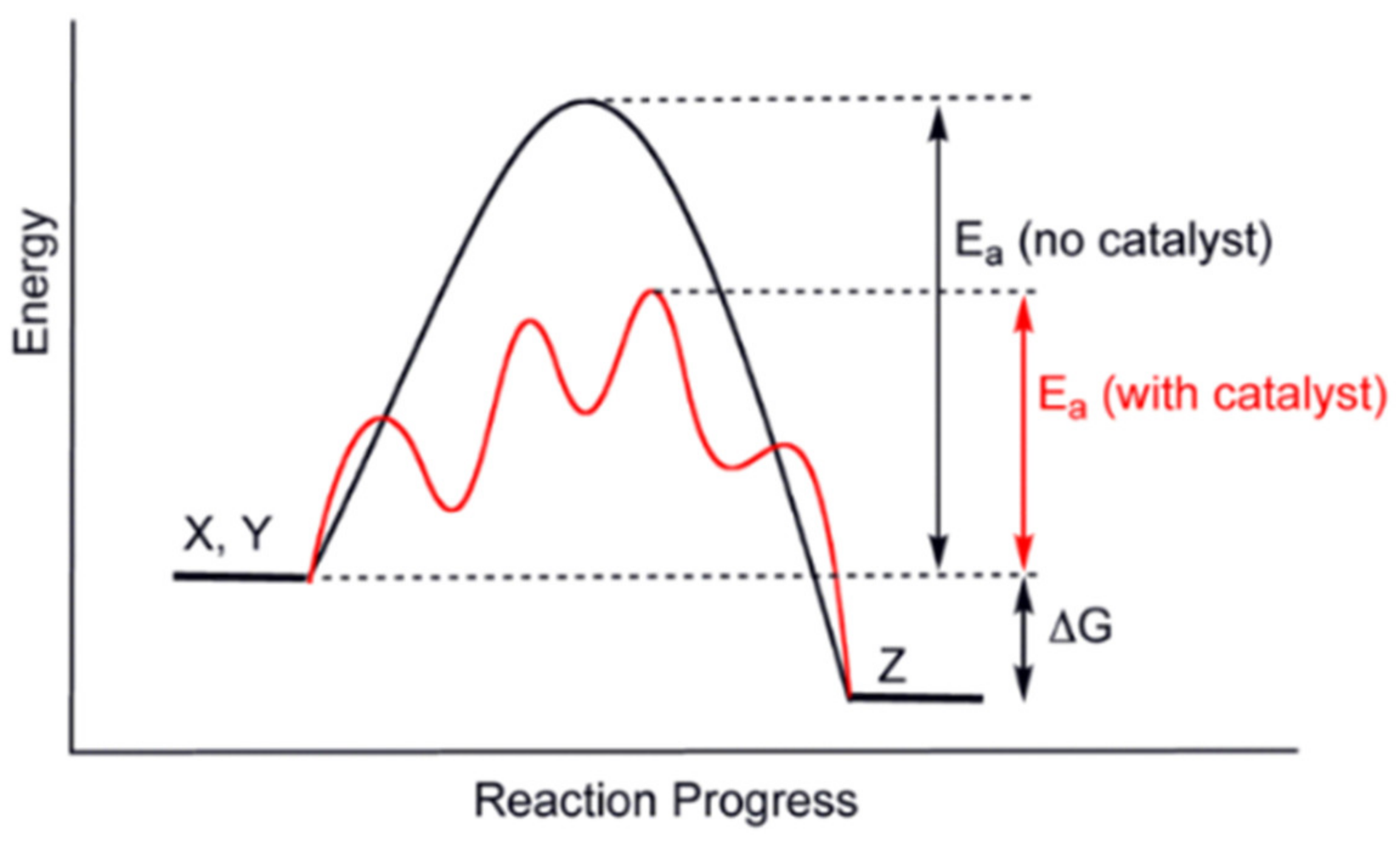
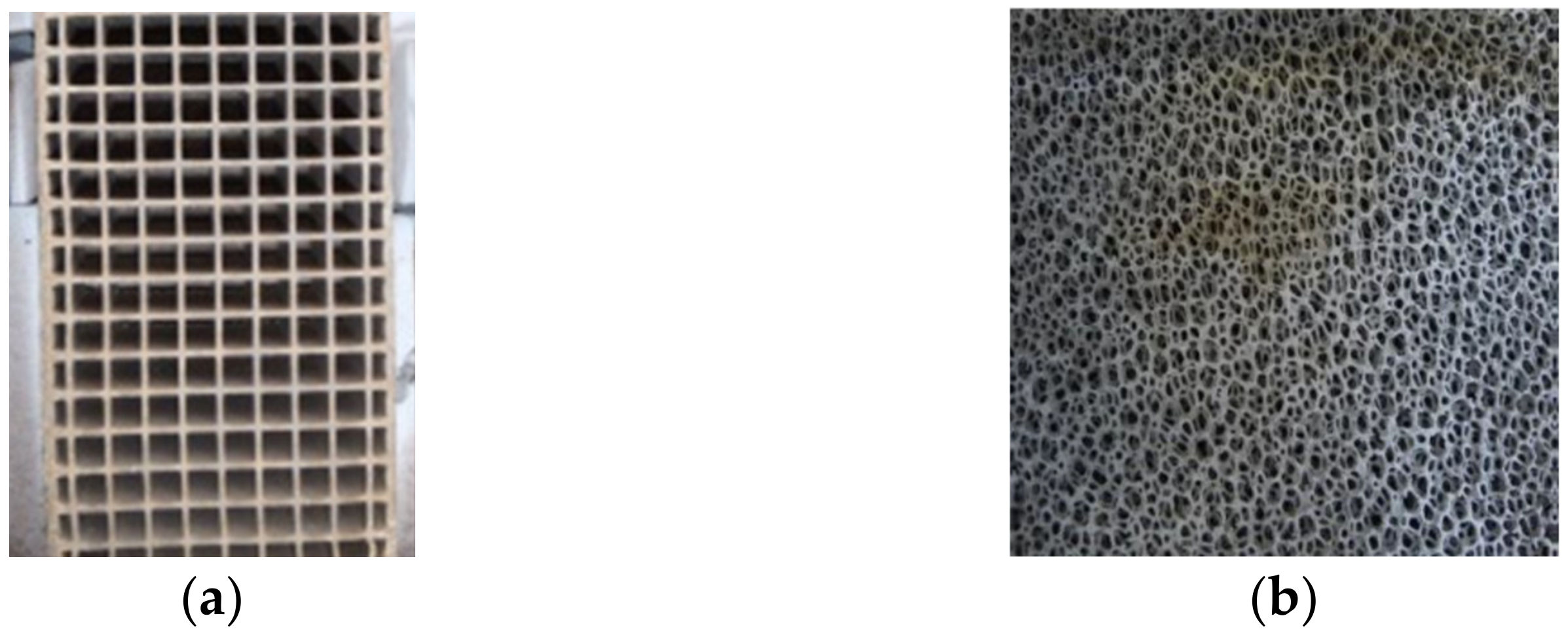
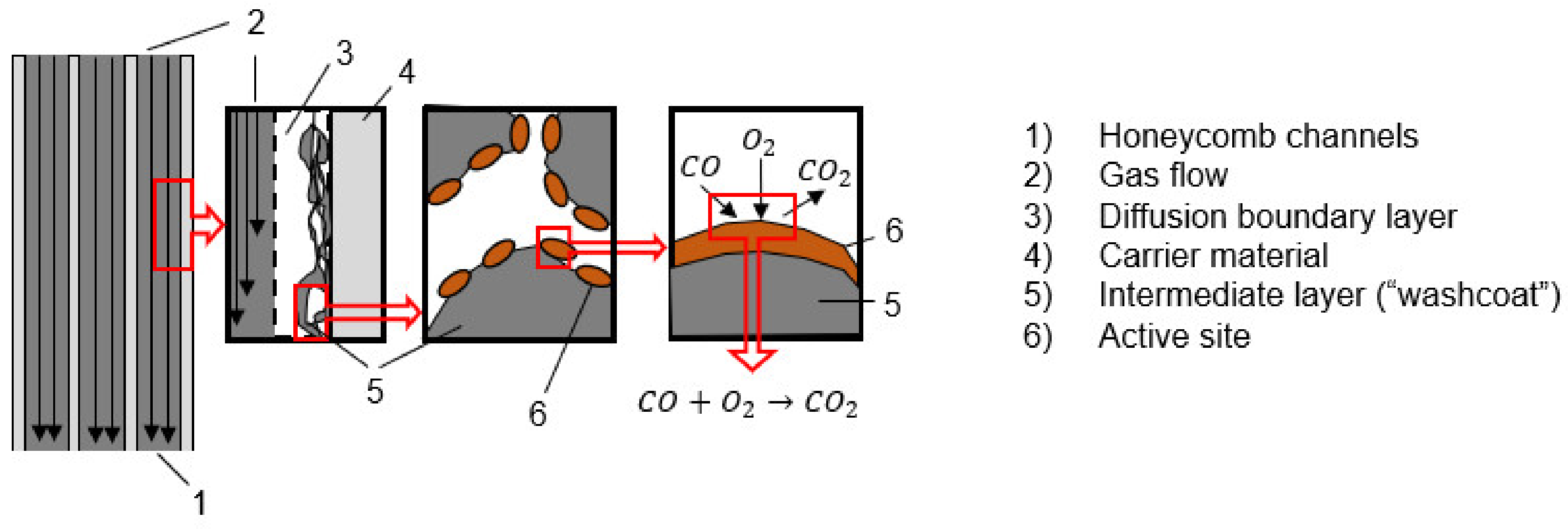
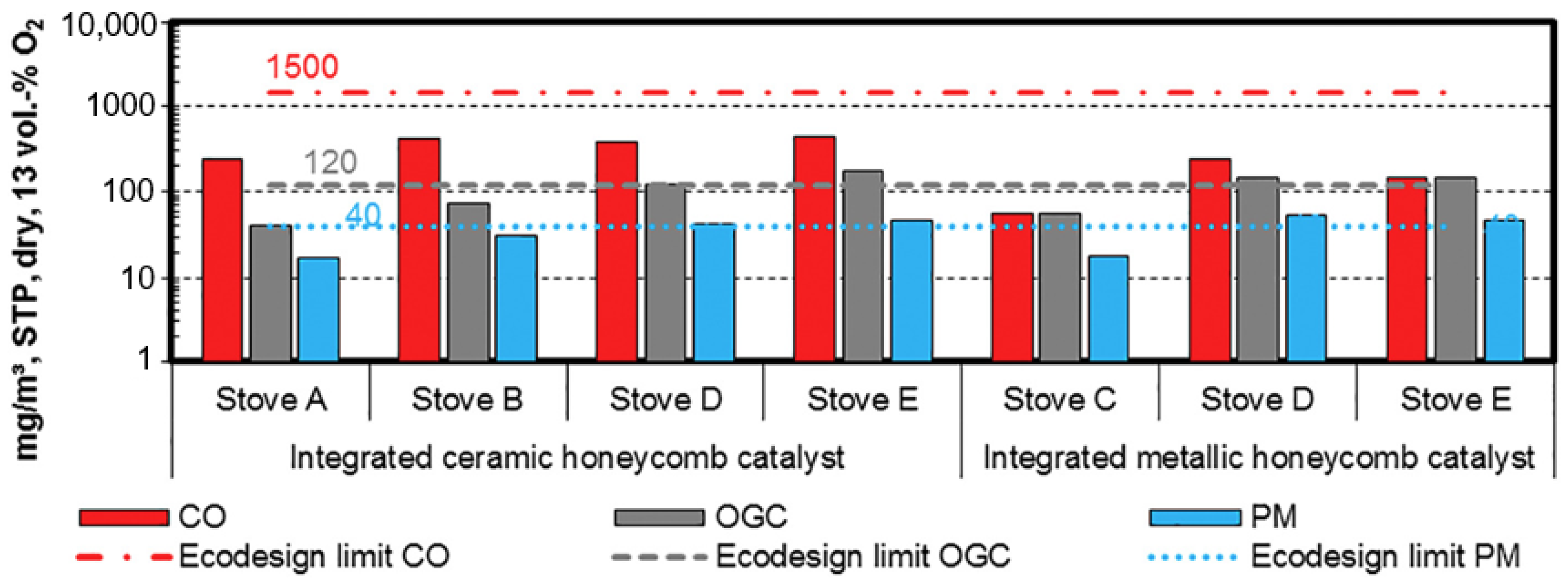

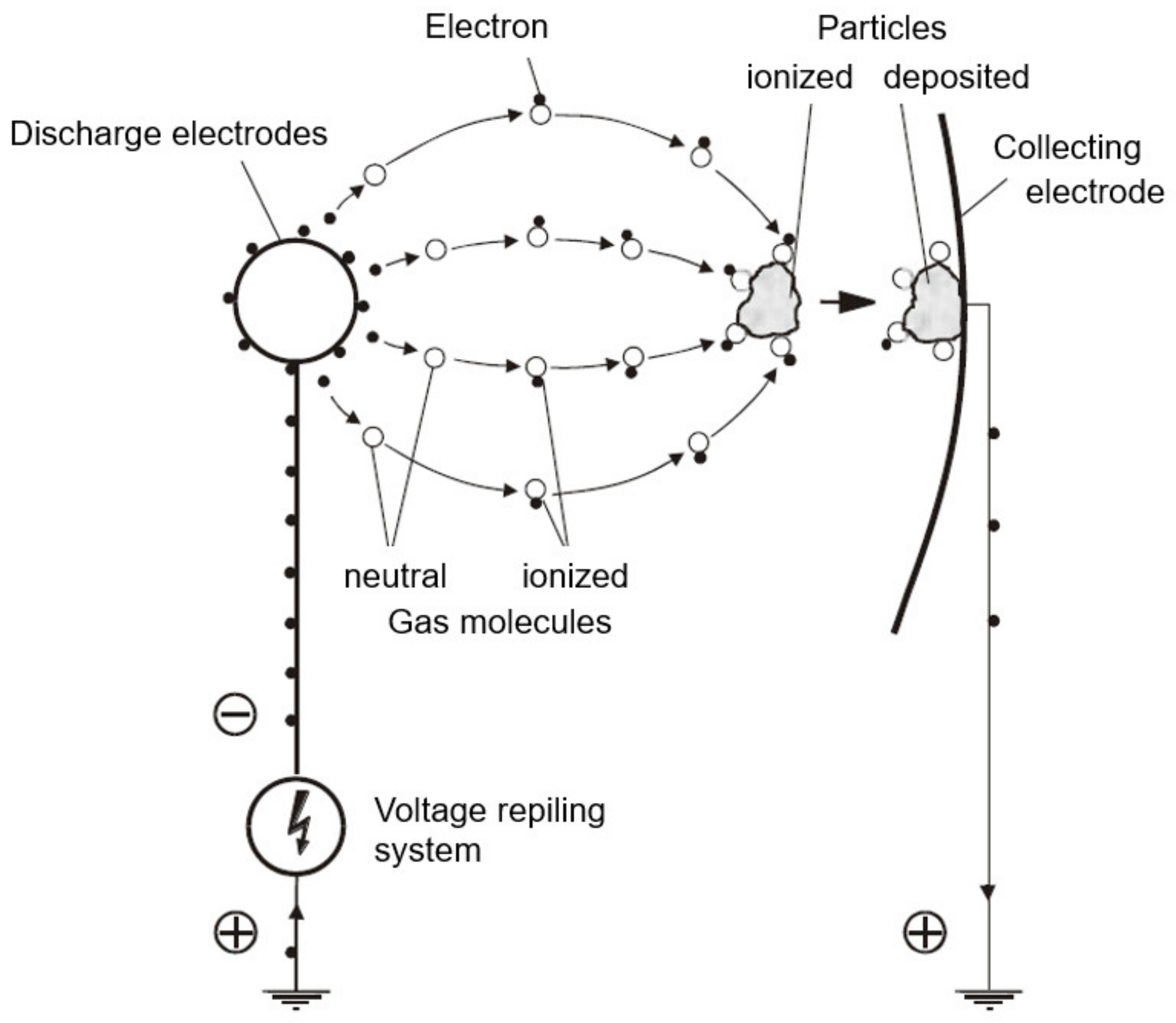
| Ignition Technique | Reference | Stove | Draught | CO * | VOC * | PM * |
|---|---|---|---|---|---|---|
| Top-down | [7,8] | “Sino L” of Spartherm Feuerungstechnik GmbH | Natural | 4111 | 847 | 73 |
| controlled (12 Pa) | 2667 | 352 | 69 | |||
| Bottom-up | Natural | 2761 | 328 | 66 | ||
| controlled (12 Pa) | 1870 | 151 | 61 | |||
| Top-down | [10] | Chimney stove (A) acc. to EN 13240 | Controlled (12 Pa) | 2732 | 362 | 100 |
| Bottom-up | Controlled (12 Pa) | 2092 | 381 | 78 | ||
| Top-down | Chimney stove (B) acc. to EN 13240 | Controlled (12 Pa) | 747 | 38 | 69 | |
| Bottom-up | Controlled (12 Pa) | 1642 | 159 | 66 | ||
| Top down | [23] | WABI (D2I INVICTA, DONCHERY, FRANCE) | Controlled (12 Pa) | 2193 | 210 | 48.8 |
| Bottom-up (traditional campfire) | Controlled (12 Pa) | 4696 | 326 | 72.1 |
| Stove | Packing Technology | CO * | VOC * | PM * |
|---|---|---|---|---|
| EN 13240 chimney stove | Without | 1356 | 122 | 32-68 |
| Metallic | 791 | 32 | 17 | |
| Ceramic | 379 | 16 | 11 | |
| EN 15250 slow-heat-release appliance | Without | 1934 | 273 | 46 |
| Metallic | 790 | 36 | 13 | |
| Ceramic | 578 | 37 | 10 |
| Secondary Measure | CO | VOC | PM |
|---|---|---|---|
| Honeycomb catalyst (metallic carrier, active sites Pt, Pd) | 70% | 55% | 27% |
| Foamed ceramic (catalytic, active sites: Pt, Pd, Rh) | 20%³ | 31% | 29% |
| Type of stove | SHRA (8kW) | SHRA (10kW) |
|---|---|---|
| Installation year | 2004 | 2017 |
| Ø chimney (mm) | 150 | 180 |
| Voltage (kV) | 30 | 30 |
| Current (µA) | 21 | 39 |
| PM (ESP ON) * | 21 | 39 |
| PM (ESP OFF) * | 147 | 98 |
| Conversion efficiency () | 86% | 60% |
| Strengths | Weaknesses |
|---|---|
|
|
| Opportunities | Threats |
|
|
| Strengths | Weaknesses |
|---|---|
|
|
| Opportunities | Threats |
|
|
| Strengths | Weaknesses |
|---|---|
|
|
| Opportunities | Threats |
|
|
| Combination | CO/VOC | PM | Natural Draught | Costs of Secondary Measure |
|---|---|---|---|---|
| Primary measures * and packing technology | ||||
| Primary measures * and catalysts | ||||
| Primary measures * and ESP | ||||
| Primary measures * and fabric baghouse filter | ||||
| Primary measures *, packing technology and fabric baghouse filter | ||||
| Primary measures *, catalyst and fabric baghouse filter | ||||
| Primary measures *, catalyst and ESP | ||||
| Primary measures *, packing technology and ESP |
Disclaimer/Publisher’s Note: The statements, opinions and data contained in all publications are solely those of the individual author(s) and contributor(s) and not of MDPI and/or the editor(s). MDPI and/or the editor(s) disclaim responsibility for any injury to people or property resulting from any ideas, methods, instructions or products referred to in the content. |
© 2023 by the authors. Licensee MDPI, Basel, Switzerland. This article is an open access article distributed under the terms and conditions of the Creative Commons Attribution (CC BY) license (https://creativecommons.org/licenses/by/4.0/).
Share and Cite
Reichert, G.; Schmidl, C. SWOT Analysis of Non-Technical and Technical Measures towards “(Nearly) Zero-Emission Stove Technologies”. Energies 2023, 16, 1388. https://doi.org/10.3390/en16031388
Reichert G, Schmidl C. SWOT Analysis of Non-Technical and Technical Measures towards “(Nearly) Zero-Emission Stove Technologies”. Energies. 2023; 16(3):1388. https://doi.org/10.3390/en16031388
Chicago/Turabian StyleReichert, Gabriel, and Christoph Schmidl. 2023. "SWOT Analysis of Non-Technical and Technical Measures towards “(Nearly) Zero-Emission Stove Technologies”" Energies 16, no. 3: 1388. https://doi.org/10.3390/en16031388




